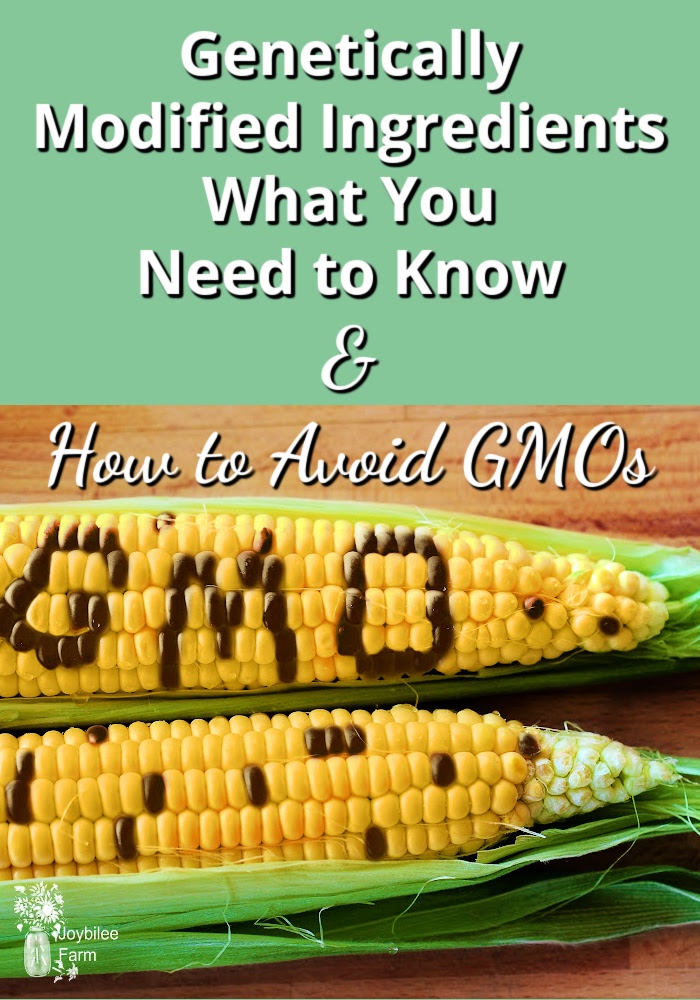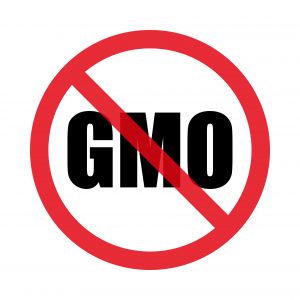Genetically Modified Ingredients – What You Need to Know & How to Avoid GMOs
Genetically Modified Ingredients – What You Need to Know & How to Avoid GMOs. Avoid GMOs by reading labels with this list in mind.

Avoiding Genetically Modified Ingredients -#30fromscratch Day 4
It’s Day 4 of the 30 Days of Cooking from Scratch Challenge and today I want to talk to you about genetically modified food or GMOs. Some of you are well aware of the dangers of Genetically Modified Food and were participants in the Worldwide March Against Monsanto that took place a week ago. Others of you are just now becoming aware of the dangers that lurk in your supermarkets, where 80% of the food sold contains at least one genetically modified ingredient. In fact, feed mills and food processors say that it’s now impossible to guarantee that any boxed food is actually 100% GMO-free. Last week the FDA found GM contamination in a wheat field in Oregon. GM Wheat has never been approved for planting and so this contamination is alarming. As a result, Europe has closed its borders to American wheat — a costly proposition for American commodity farmers.
1996 – The Pivotal Year
In 1996 nobody had ever heard of genetically modified food. The patent owners had not yet made war on farmers by contaminating fields with GM seeds or pollen and then prosecuting farmers to drive their patent rights before the courts. Within a few years, the farming communities around the world had polarized and the victims had lost their farms to legal fees and their crops to the patent owner. I heard Percy Schmeizer, a Canadian Farmer that was taken to the Supreme Court of Canada by Monsanto, speak in Grand Forks 4 years ago and his message changed me.
In 1996, I lived in the Fraser Valley of BC. The dairy farmers were growing GM maize to feed their cattle. The crop was experimental. It wasn’t an approved crop. All over the fields, there were warning signs that the corn was not safe for human consumption. At that time the GM corn crop was being fed to dairy cows. The milk from those cows was pooled milk that was collected and shipped to the Dairyland processing plants and cheese factories in BC. It was at that time that my toddler daughter was diagnosed with cow’s milk allergies and we switched to goat’s milk and started on our path to Joybilee Farm. Is there a connection? I can’t say. Is there a connection between the huge rise in food allergies since 1997 and the commercialization of GM corn, soy, and other commodity crops? We may never know, because, at least in North America, if you want to test GM food for anything, as a scientist, you have to go through the patent owner. They own the seeds from the time of planting until it’s pooped out at the other end of the consumer. If the GM gene is still in the poop, they might even own that.
What we know about GM ingredients
What we do know is that the GM gene is active inside the consumer – it isn’t destroyed by stomach acid, as was once reported by the patent owner. This active transmuted gene changes the DNA of the consumer’s cells at the cellular level. Biological products like breast milk and eggs contain the transmuted gene, too, if the consumer is fed GM products. Consider the implications.
The common genetically modified ingredients include corn and its derivatives, soy and its derivatives, canola and its derivatives, sugar from sugar beets, and cottonseed oil. To complicate matters, livestock fed commercial feed will be fed the cast-offs that result from these GM ingredients being prepared for the food processing industry, such as canola or cottonseed meal, cracked corn, or beet pulp. While this isn’t a complete list of genetically modified ingredients, it includes the most common ones that you are likely to find in your processed food.
The 30 days of Cooking from Scratch Challenge
Our goal in the 30 days cooking from scratch challenge isn’t simply to make processed food at home from scratch, but rather to change what we eat to be more healthy and to avoid genetically modified ingredients that have been shown to damage DNA and cause cancer in animals.
Avoiding GMO foods isn’t as simple as only buying organic, because GMOs will cross pollinate with nonGM plant varieties and contaminate the gene pool. Once the contamination occurs it can’t be taken back. Organic farms normally will not be tested for GM contamination; because of the expensive repercussions should GM genes be found in the seed stock. Contamination can also occur during transport, and at grain mills and other distribution channels. So while we might not be able to completely avoid GMOs in our diet, we can make a good effort to minimize them by avoiding common ingredients known to be genetically modified.
Common Ingredients that are often Genetically Modified
Here is a list of the common ingredients that you will find on your processed food labels that will most likely be GMOs.
Corn and its derivatives:
Citric acid
Corn starch, starch,
Vegetable oil
Corn oil
Corn syrup, HFC,
Hydrogenated vegetable oil,
Textured vegetable protein
Margarine
Vegetable oil
Hydrogenated vegetable oil
Masa Harina (used for making tortillas)
Corn flour
Cornmeal
Popcorn
Sweet corn, niblets, cream corn, fresh sweet corn
Soy and its derivatives
Textured Vegetable protein
Soya sauce
Soy milk, soya milk
Soybean meal
Soy oil, soya oil,
Soybean paste,
Tofu
Miso
Tamari
Soy flour, soya flour
Edema, soybeans, soybean pods
MSG, glutamate, spices, flavouring,
Cotton and its derivatives
Cottonseed oil
Margarine
Shortening
Cottonseed meal (sold as a livestock feed and as “organic” fertilizer)
Hydrogenated Vegetable Oil
Canola and its derivatives
Canola oil
Canola seed meal (sold as a livestock feed and as “organic” fertilizer)
Rapeseed oil
Margarine
Rapeseed
Hydrogenated Vegetable oil
Sugar Beets and their derivatives
Beet Pulp (used as livestock feed)
Sugar
Molasses
Brown sugar
Icing sugar
White sugar
Demerara sugar
(Cane sugar has not been genetically modified)
Other ingredients that may be genetically modified:
Wheat grown in the USA
Alfalfa grown in the USA
Flax grown in the USA
Potatoes grown in the USA
Tomatoes grown in the USA
Papaya
Pineapple
Mangoes
Apples grown commercially in BC or Washington
Rice (look for nonGMO on the label)
Spices
Aspartame
This is not a complete list.
Why are GMOs a problem?
Any product that has “grown organically” on the label that is not “Certified Organic” or any product that is less than 98% organic and is “Certified Organic,” may contain GM ingredients, unless the product also says non-GMO.
Because genetically modified crops have been sown before 1997, the gene pool of other similar species has also been contaminated with GM genetics. For instance, Canola/rape crops have cross pollinated with wild mustard plants. Once the genetics have escaped it is impossible to take them back.
If GM crops were benign, as many scientists believed at first, this would be a nonissue. But animal feeding tests have shown that genetically modified foods cause cancer and infertility and affect the genetics of future generations. In one study, rats fed GM soy had fertility problems. The second generation had only 50% success breeding. The experiment ended in the 3rd generation, where 100% of the offspring were sterile. Feeding experiments using GM corn resulted in massive tumours in only a few months of feeding genetically modified corn. BSE, a brain disease that affects cattle, is officially blamed on the feeding of animal products to livestock, quite possibly was the result of feeding canola/rapeseed meal to cattle in the UK. This practice continues in Canada, where BSE is still being found, although the feeding of animal products to livestock is illegal, but the feeding of canola seed meal is a common practice. If you raise livestock check with your feed mill for the ingredients in your livestock feed. Ditto for your dog and cat food.
An attempt is being made in many countries to destroy GM plantings by firing fields where crops are found to contain the genes of genetically modified plants. It remains to be seen if this will be effective in eliminating GM crops from the environment. Governments in the US and Canada are not motivated to try to eradicate GM plantings. Nor are genetically modified ingredients labelled as such. The onus is on the buyer to understand ingredient labels and take personal responsibility. Don’t eat poison. Learn to read labels and educate yourself about the threat that genetically modified food represents to humans, animals, and the environment.
Monsanto has become the Icon in the war against GM food, but they are not the only player
And be aware that Monsanto is not the only patent owner of genetically modified food. While Monsanto has been painted as the only villain, other corporations are also in the genetic modification game, including Microsoft, a heavy supporter of GM food, Syngenta, another GM patent holder, and several pharmaceutical companies that have plant patents for GM plants that are growing drugs that can later be extracted.
Worldwide free showing of Genetic Roulette on June 15th
For more information on Genetically Modified Foods watch the video “Genetic Roulette” – there will be a worldwide free online showing on June 15th. Check out the website: www.responsibletechnology.org for viewing.




So, this seems like a lot to do and be aware of….. Is there a No GMO for Dummies book!! Where does someone like me start?
I didn’t realize how widespread GMO products were. Thank you for this articule.